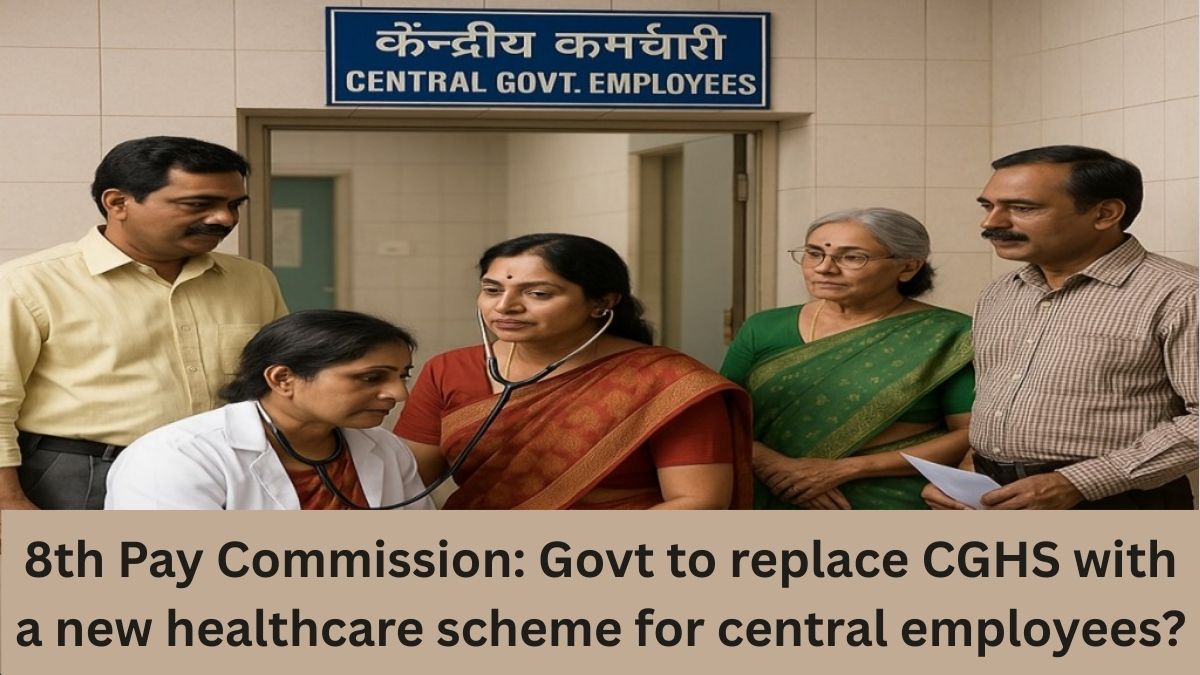With the formation of the 8th Pay Commission, a renewed spotlight has been cast on the healthcare benefits of central government employees and pensioners. While salary hikes and pension revisions are typically seen as the commission’s primary objectives, its role extends beyond pay adjustments. One of the most awaited potential reforms is the modernization or replacement of the Central Government Health Scheme (CGHS)—a long-standing demand from employee unions and experts.
The focus has now shifted to whether the new commission will push forward with the proposal to replace CGHS with a more accessible, insurance-based scheme called the Central Government Employees and Pensioners Health Insurance Scheme (CGEPHIS).

What is CGHS and Why Is It Under Review?
The Central Government Health Scheme (CGHS) was introduced to offer affordable and comprehensive medical care to central government employees, pensioners, and their families. It provides access to outpatient consultations, hospitalization, diagnostic services, and prescribed medications at subsidized rates through a network of CGHS dispensaries and empanelled hospitals.
However, the scheme has faced criticism over the years due to several limitations:
-
Inadequate coverage in rural and semi-urban areas
-
Overburdened dispensaries in urban locations
-
Long waiting periods and limited empanelled hospitals
-
Restricted availability of specialist services
Previous Pay Commissions and Their Recommendations on Healthcare
Concerns around the inefficiency and limited reach of CGHS are not new. The 6th and 7th Pay Commissions had already flagged the need for a more inclusive and scalable healthcare system.
6th Pay Commission: Voluntary Health Insurance Proposal
The 6th Pay Commission recommended introducing an optional health insurance scheme for government employees and pensioners. Key suggestions included:
| Recommendation | Details |
|---|---|
| Voluntary Participation | Existing employees could opt in by paying a fixed contribution |
| Mandatory for New Joinees | New government recruits should be automatically enrolled |
| Post-Retirement Benefits | Coverage must extend to retirees who join the scheme |
7th Pay Commission: Push for a Unified Health Insurance Scheme
The 7th CPC went further, calling health insurance the most viable solution for long-term healthcare. It advised:
-
Implementing an insurance-backed healthcare scheme accessible nationwide
-
Empanelment of private hospitals under CS(MA) and ECHS to offer cashless treatment to pensioners outside CGHS areas
-
Enhancing administrative capacity at CGHS centers to handle the additional load
These were seen as practical solutions to bridge the gaps left by CGHS, especially for pensioners and employees residing in non-metro regions.
What is CGEPHIS and How Is It Different?
The proposed Central Government Employees and Pensioners Health Insurance Scheme (CGEPHIS) is being considered as a potential replacement for CGHS. Though no official notification has been released yet, internal sources suggest that the Ministry of Health and Family Welfare has been evaluating the feasibility of the model.
Key Features of CGEPHIS (Proposed)
| Parameter | Details |
|---|---|
| Scheme Type | Insurance-based (to be operated by IRDAI-registered insurers) |
| Beneficiaries | All serving central government employees and pensioners |
| Hospital Network | Pan-India access to empanelled private and public hospitals |
| Cashless Services | End-to-end cashless coverage for treatment, diagnostics, and surgery |
| Coverage for Dependents | Likely to include spouse, children, and dependent parents |
If implemented, CGEPHIS would eliminate geographical limitations, improve ease of access, and bring private-sector efficiency to the delivery of healthcare.
Why Healthcare Reform Is Essential Now
With rising healthcare costs, especially post-pandemic, public sector employees require reliable, cashless, and widely accessible medical services. The CGHS, while pioneering in its time, is now seen as outdated and under-resourced. Many pensioners living in remote or tier-2 cities remain excluded from its coverage.
Furthermore, with the central government promoting Digital India and expanding Ayushman Bharat, the time seems ripe for an overhaul of legacy systems like CGHS. The 8th Pay Commission is expected to take a bold stance on this issue.
Current Status and What Lies Ahead
As of January 2025, the Health Ministry has not officially confirmed the implementation of CGEPHIS, but discussions are reportedly in advanced stages. The new pay commission may give this policy shift the final push by including it in its list of formal recommendations.
All eyes are now on the 8th Pay Commission to break the long-standing impasse and introduce reforms that will reshape how central government employees and pensioners access medical care.
Frequently Asked Questions
Q1. What is the CGHS and who is eligible for it?
A: CGHS is a government-run healthcare scheme providing subsidized medical services to central government employees, pensioners, and their dependents.
Q2. Why is CGHS being reconsidered for replacement?
A: Due to its limited geographic coverage, outdated infrastructure, and inability to meet growing demand, CGHS is seen as inadequate for today’s needs.
Q3. What is CGEPHIS and how will it help?
A: CGEPHIS is a proposed insurance-based healthcare scheme that promises nationwide, cashless access to healthcare services via private and public hospitals.
Q4. Has CGEPHIS been officially implemented?
A: No, it is still under consideration, but the 8th Pay Commission may formally recommend its rollout.
Q5. Will pensioners also benefit from the new scheme?
A: Yes, the proposed scheme is expected to cover both serving employees and pensioners, along with their eligible dependents.
Click here to know more.



